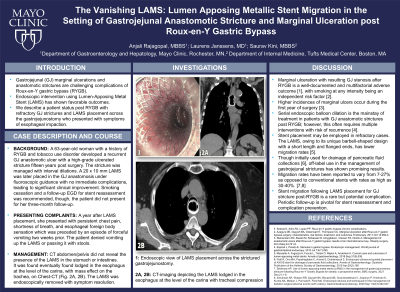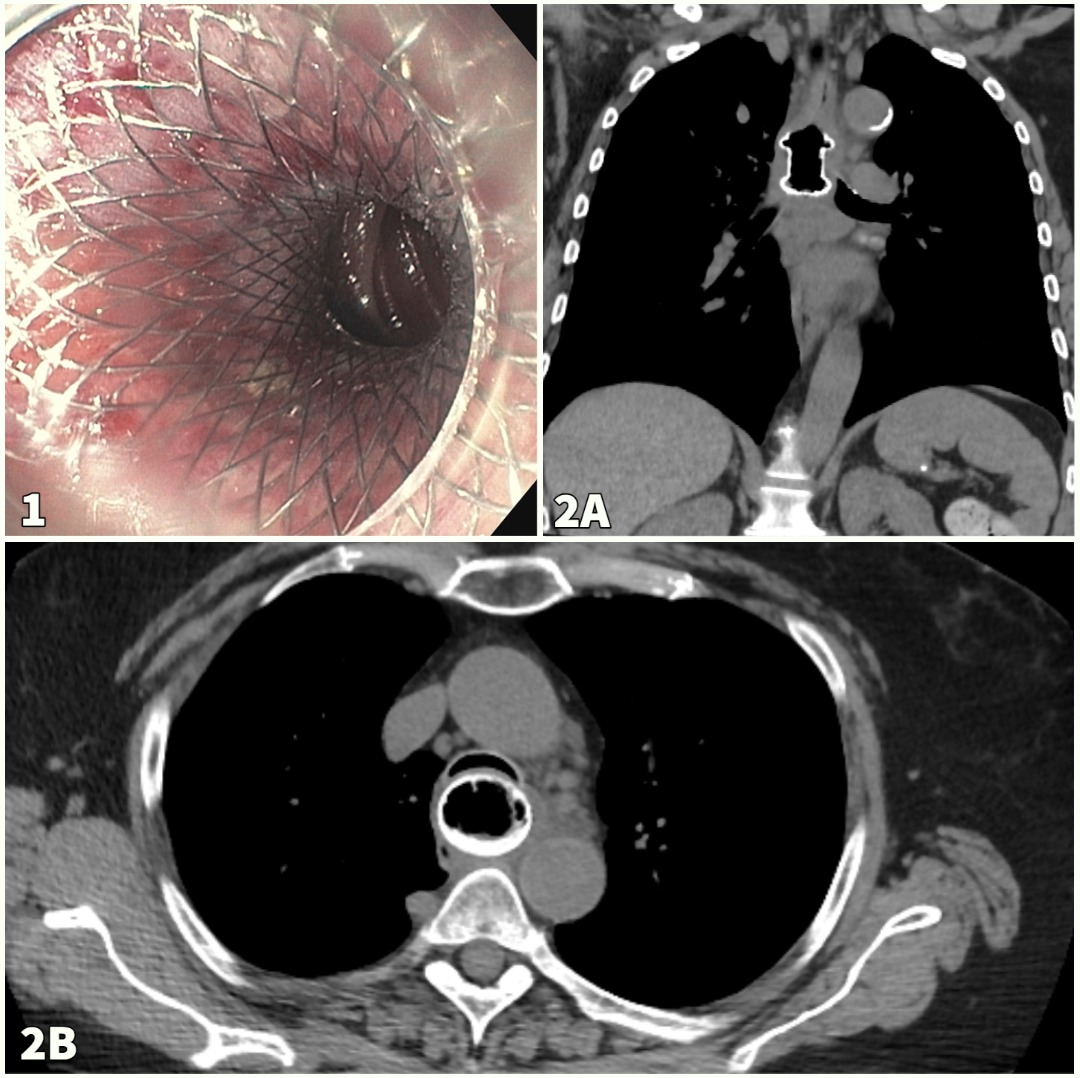Tuesday Poster Session
Category: Interventional Endoscopy
P3753 - The Vanishing LAMS: Lumen-Apposing Metal Stent Migration in the Setting of Gastrojejunal Anastomotic Stricture and Marginal Ulceration Post Roux-En-Y Gastric Bypass
Tuesday, October 24, 2023
10:30 AM - 4:00 PM PT
Location: Exhibit Hall

Has Audio

Anjali Rajagopal, MBBS
Mayo Clinic
Rochester, MN
Presenting Author(s)
Anjali Rajagopal, MBBS1, Laurens Janssens, MD1, Saurav Kini, MBBS2
1Mayo Clinic, Rochester, MN; 2Tufts Medical Center, Boston, MA
Introduction: Gastrojejunal (GJ) marginal ulcerations and anastomotic strictures are challenging complications of Roux-en-Y gastric bypass (RYGB). Endoscopic intervention using Lumen-Apposing Metal Stent (LAMS) has shown favorable outcomes. We describe a patient status post RYGB with refractory GJ strictures and LAMS placement across the gastrojejunostomy who presented with symptoms of esophageal impaction.
Case Description/Methods: A 63-year-old woman with a history of RYGB eighteen years ago and tobacco use disorder developed a recurrent GJ anastomotic ulcer with a high-grade ulcerated stricture fifteen years post-surgery. The stricture was first managed with interval dilations. Eventually, a 20 x 10 mm LAMS was placed in the GJ anastomosis under fluoroscopic guidance with no immediate complications, resulting in significant clinical improvement. Smoking cessation and a follow-up EGD for stent reassessment was recommended, however, the patient did not present for her three-month follow-up. A year after LAMS placement, she presented with complaints of persistent chest pain, shortness of breath, and esophageal foreign body sensation after an episode of forceful vomiting two weeks prior. CT abdomen/pelvis did not reveal the presence of LAMS in the stomach or intestines. The patient denied vomiting up the LAMS or passing it with stools. Chest CT was performed, and the LAMS was found to be lodged in the esophagus at the level of the carina, with mass effect on the trachea. The LAMS was endoscopically removed with symptom resolution.
Discussion: Marginal ulceration with resulting GJ stenosis after RYGB is a well-documented and multifactorial adverse outcome, with smoking at any intensity being an independent risk factor. Higher incidences of marginal ulcers occur during the first year of surgery. Serial endoscopic balloon dilation is the mainstay of treatment in patients with GJ anastomotic strictures post RYGB; however, this often requires multiple interventions with risk of recurrence. Stent placement may be employed in refractory cases. The LAMS, owing to its unique barbell-shaped design with a short length and flanged ends, has lower migration rates. Though initially used for drainage of pancreatic fluid collections, off-label use in the management of gastrojejunal strictures has shown promising results. Migration rates have been reported to vary from 7-27% as opposed to conventional stents with rates as high as 30-40%. Periodic follow-up is pivotal for stent reassessment and complication prevention.

Disclosures:
Anjali Rajagopal, MBBS1, Laurens Janssens, MD1, Saurav Kini, MBBS2. P3753 - The Vanishing LAMS: Lumen-Apposing Metal Stent Migration in the Setting of Gastrojejunal Anastomotic Stricture and Marginal Ulceration Post Roux-En-Y Gastric Bypass, ACG 2023 Annual Scientific Meeting Abstracts. Vancouver, BC, Canada: American College of Gastroenterology.
1Mayo Clinic, Rochester, MN; 2Tufts Medical Center, Boston, MA
Introduction: Gastrojejunal (GJ) marginal ulcerations and anastomotic strictures are challenging complications of Roux-en-Y gastric bypass (RYGB). Endoscopic intervention using Lumen-Apposing Metal Stent (LAMS) has shown favorable outcomes. We describe a patient status post RYGB with refractory GJ strictures and LAMS placement across the gastrojejunostomy who presented with symptoms of esophageal impaction.
Case Description/Methods: A 63-year-old woman with a history of RYGB eighteen years ago and tobacco use disorder developed a recurrent GJ anastomotic ulcer with a high-grade ulcerated stricture fifteen years post-surgery. The stricture was first managed with interval dilations. Eventually, a 20 x 10 mm LAMS was placed in the GJ anastomosis under fluoroscopic guidance with no immediate complications, resulting in significant clinical improvement. Smoking cessation and a follow-up EGD for stent reassessment was recommended, however, the patient did not present for her three-month follow-up. A year after LAMS placement, she presented with complaints of persistent chest pain, shortness of breath, and esophageal foreign body sensation after an episode of forceful vomiting two weeks prior. CT abdomen/pelvis did not reveal the presence of LAMS in the stomach or intestines. The patient denied vomiting up the LAMS or passing it with stools. Chest CT was performed, and the LAMS was found to be lodged in the esophagus at the level of the carina, with mass effect on the trachea. The LAMS was endoscopically removed with symptom resolution.
Discussion: Marginal ulceration with resulting GJ stenosis after RYGB is a well-documented and multifactorial adverse outcome, with smoking at any intensity being an independent risk factor. Higher incidences of marginal ulcers occur during the first year of surgery. Serial endoscopic balloon dilation is the mainstay of treatment in patients with GJ anastomotic strictures post RYGB; however, this often requires multiple interventions with risk of recurrence. Stent placement may be employed in refractory cases. The LAMS, owing to its unique barbell-shaped design with a short length and flanged ends, has lower migration rates. Though initially used for drainage of pancreatic fluid collections, off-label use in the management of gastrojejunal strictures has shown promising results. Migration rates have been reported to vary from 7-27% as opposed to conventional stents with rates as high as 30-40%. Periodic follow-up is pivotal for stent reassessment and complication prevention.

Figure: 1. LAMS placement across the strictured gastrojejunostomy.
2A, 2B LAMS lodged in the esophagus at the level of the carina with compression of the trachea.
2A, 2B LAMS lodged in the esophagus at the level of the carina with compression of the trachea.
Disclosures:
Anjali Rajagopal indicated no relevant financial relationships.
Laurens Janssens indicated no relevant financial relationships.
Saurav Kini indicated no relevant financial relationships.
Anjali Rajagopal, MBBS1, Laurens Janssens, MD1, Saurav Kini, MBBS2. P3753 - The Vanishing LAMS: Lumen-Apposing Metal Stent Migration in the Setting of Gastrojejunal Anastomotic Stricture and Marginal Ulceration Post Roux-En-Y Gastric Bypass, ACG 2023 Annual Scientific Meeting Abstracts. Vancouver, BC, Canada: American College of Gastroenterology.
